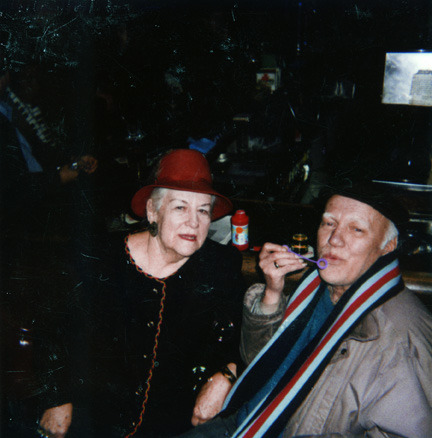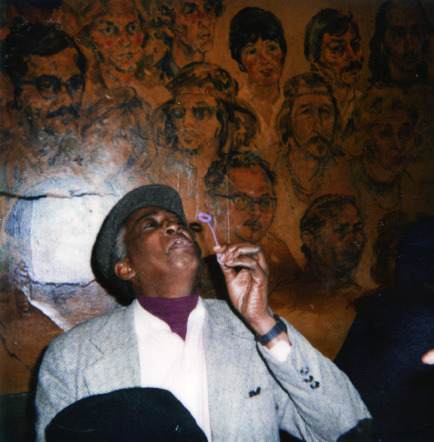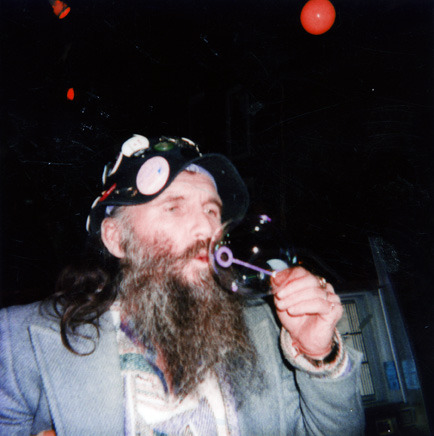Polaroids and Bubbles

Midge.
Jan. 13, 2011—
The Old Town Ale House was not a happy bar when I drank there.
It is in the Old Town neighborhood of Chicago, just a lucky weave and blind step south of the Second City theater.
I haven’t been there in a couple years, but the last time I was at the Ale House it had been discovered by a new generation of late night revelvers. I was not happy.
The Ale House is open until 5 a.m. on Sunday and 4 a.m. the rest of the week. It has always been a lighthouse for just-off-the-shift bartenders and waitstaff, miserable deadline reporters and Second City actors trying to bottle their adrenaline.
As we drove by the Ale House during last fall’s tour with Hugh Hefner and his twin sons I pointed out the tavern with its rustic Wild West exterior. I told Hef’s sons how actor-comedian Chris Farley dropped in the bar on his last night on this mortal coil. They perked up.
Back when I was hanging out at the Ale House in the early 1990s I was in the jet stream of a divorce. This was a perfect landscape for me. Most people had worse problems. The jukebox played blue songs like Rosemary Clooney’s “Sweet Kentucky Ham.”
The place was full of colorful regulars in a black and white world.
One guy walked around with a nickel in his ear. People had sex in the bathroom. One woman had appeared on the Tom Snyder show for some sexual diversion.
The late Bobby Freitag was piano player at Orso’s Italian restaurant and a man who loved playing the role of the curmudgeon. He’s one of the few lounge singers I knew who never sang. He had a great joke about his singing: “They heard me once. I had a little too much to drink and started singing.”
“They said, ‘Don’t do it again, please.’
“I thought they meant the drinking.”
Freitag would give me the finger from his gnarled left hand when I walked into the Ale House. Then he would ask me to sit down on his right side.

Bob Freitag (with bubble blower).
Even the tavern’s east wall had depressing stories.
Between 1972 and 1974 Chicago artist Maureen Munson painted faces of Ale House hustlers, bards, junkies and porn stars on the wall. There were fantasy CIA agents and AIDS victims. I was told the wall contained three suicides. One of the suicides always carried a parrot on his shoulder. Munson liked to drink beer and whiskey.
No one knew what became of her.

Tiny Bubbles (Munson on mural above right)
Late one night we decided to march through the Ale House with a small red bottle of
blow bubbles (with wand) and a Polaroid camera.
I don’t recall how this happened, it might have been Midge’s idea. We wanted to lighten up the mood of these soggy barnacles.
We approached the dark characters with the bright plastic bottle. We asked them to take the wand and blow a bubble into the camera. Guess what?
Everyone participated. Everyone smiled. Even Freitag.

Az; singer-songwriter-big bubble blower.
This sealed the deal with the Polaroid camera for me.
I’ve never strayed too far away from tactile experiences. The Polaroid is a process for sure. I still love the smell of a newspaper and turning its pages. I enjoy taking a slab of black vinyl out of a record jacket and placing it on a turntable. It creates a connection that seems to be floating away in this A.D.D. culture.
This past New Year’s Eve at the Empty Bottle music club in Chicago a twentysomething woman took our picture with a new Polaroid camera. I was impressed. She showed her friends how this contraption spewed out a photo on the spot.
It was the second time this Polarid portrait had happened the last three New Year’s Eves. It hasn’t happened any other time of the year.

We talked briefly about Polaroids and how to track down Polaroid film. I had loaded up my Polaroid One Step with 600 film—although I have yet to snap any photos. I didn’t even know that Polaroid was no longer making film and that the Impossible Project in the Netherlands had acquired original Polaroid machinery.
It just seems that the cumbersome geekery of the Polaroid always makes folks smile.
I’m happy about these developments.


Leave a Response